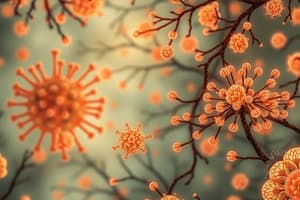Podcast
Questions and Answers
Which CD molecule is responsible for supporting the T-cell receptor (TCR) and transducing signaling when engaged?
Which CD molecule is responsible for supporting the T-cell receptor (TCR) and transducing signaling when engaged?
- CD8
- CD3 (correct)
- CD19
- CD4
Which CD molecule is primarily found on helper T-cells and is important for recognizing antigens presented by MHC class II molecules?
Which CD molecule is primarily found on helper T-cells and is important for recognizing antigens presented by MHC class II molecules?
- CD4 (correct)
- CD20
- CD28
- CD8
What is the main site of maturation for B lymphocytes in several mammalian species, including humans and mice?
What is the main site of maturation for B lymphocytes in several mammalian species, including humans and mice?
- Spleen
- Lymph node
- Thymus
- Bone marrow (correct)
Which method is NOT used to classify lymphocytes?
Which method is NOT used to classify lymphocytes?
Which size range is INCORRECTly matched with lymphocyte morphology?
Which size range is INCORRECTly matched with lymphocyte morphology?
Which type of lymphocyte is primarily involved in the adaptive immune response?
Which type of lymphocyte is primarily involved in the adaptive immune response?
Which type of cells have MHC Class II markers?
Which type of cells have MHC Class II markers?
Why are cells without the specific MHC markers classified as non-self?
Why are cells without the specific MHC markers classified as non-self?
In terms of immune system recognition, what happens to cells marked as 'self'?
In terms of immune system recognition, what happens to cells marked as 'self'?
What is the main function of MHC Class I markers?
What is the main function of MHC Class I markers?
How are non-self cells perceived by the immune system?
How are non-self cells perceived by the immune system?
Which statement accurately describes the role of receptors in immune responses?
Which statement accurately describes the role of receptors in immune responses?
What is the main role of eosinophils in the immune system?
What is the main role of eosinophils in the immune system?
Which cells express HLA class II proteins on their surface?
Which cells express HLA class II proteins on their surface?
What distinguishes HLA class I from HLA class II molecules?
What distinguishes HLA class I from HLA class II molecules?
What is the significance of the MHC genes polymorphism?
What is the significance of the MHC genes polymorphism?
Which immune response does the HLA system play a major role in?
Which immune response does the HLA system play a major role in?
Flashcards are hidden until you start studying
Study Notes
Cluster of Differentiation Molecules
- Cluster of differentiation (CD) molecules are found on the surfaces of many cell types and serve as indicators of the functional capacities of leukocytes and other cells.
- Over 350 CD molecules have been identified.
CD Molecules in Adaptive Immunity
- Three major CD molecules are important in adaptive immunity: CD3, CD4, and CD8.
- CD3 supports the T-cell receptor (TCR) and transduces trans-membrane signaling when the TCR is engaged.
Lymphocytes
- Lymphocytes are the major cells of the adaptive immune system.
- They can be classified according to three general methods: type of receptors involved, place of basic training, and type of expression of membrane molecules (CD).
- Lymphocytes range in size from small (4-7 µm) to large (11-15 µm).
B Lymphocytes (B Cells)
- B lymphocytes derive their name from bone marrow, their major site of maturation.
- They can be distinguished by their expression of membrane molecules known as cluster of differentiation (CD).
Eosinophils
- Eosinophils have "eosin-living" granules and are bilobed granulocytes with cytoplasmic granules that contain basic proteins.
- They are an active component in both innate and adaptive immune responses to parasitic infections.
Major Histocompatibility Molecules (MHC)
- MHC molecules are also known as the human leukocyte antigen (HLA) complex.
- They are a segment of chromosome 6 containing several genes that encode enzymes and structural molecules needed for the activation and function of B and T cells.
- MHC molecules play a major role in considering a transplant tissue as foreign or not (histocompatibility).
HLA Molecules
- HLA class I molecules are expressed on the surface of almost all nucleated cells.
- They consist of a large polypeptide (α-polypeptide) and a small polypeptide (β2-microglobulin).
- HLA class I molecules can bind to short antigenic peptides in their groove.
- HLA class II molecules are expressed on the surface of antigen-presenting cells (macrophages, dendritic cells, and B cells).
- They consist of two large polypeptides (α and β polypeptides).
Distinguishing between Self and Non-Self
- The immune system coexists with every cell in the body, which are identified as 'self' and marked with protein markers coded by the major histocompatibility complex (MHC) genes.
- Any cell that does not display the specific MHC marker is treated as an antigen.
MHC Proteins
- MHC Class I proteins are found on all body cells that have a nucleus.
- MHC Class II proteins are found only on B and T lymphocytes and macrophages.
- Both markers contribute to the specific identity of the cell.
Receptors in the Immune System
- Receptors are important for the function of the immune system.
- Engagement of receptors provides a wide range of responses depending on the type of cell or molecule associated with the receptor and the type of receptor and ligand.
Studying That Suits You
Use AI to generate personalized quizzes and flashcards to suit your learning preferences.




